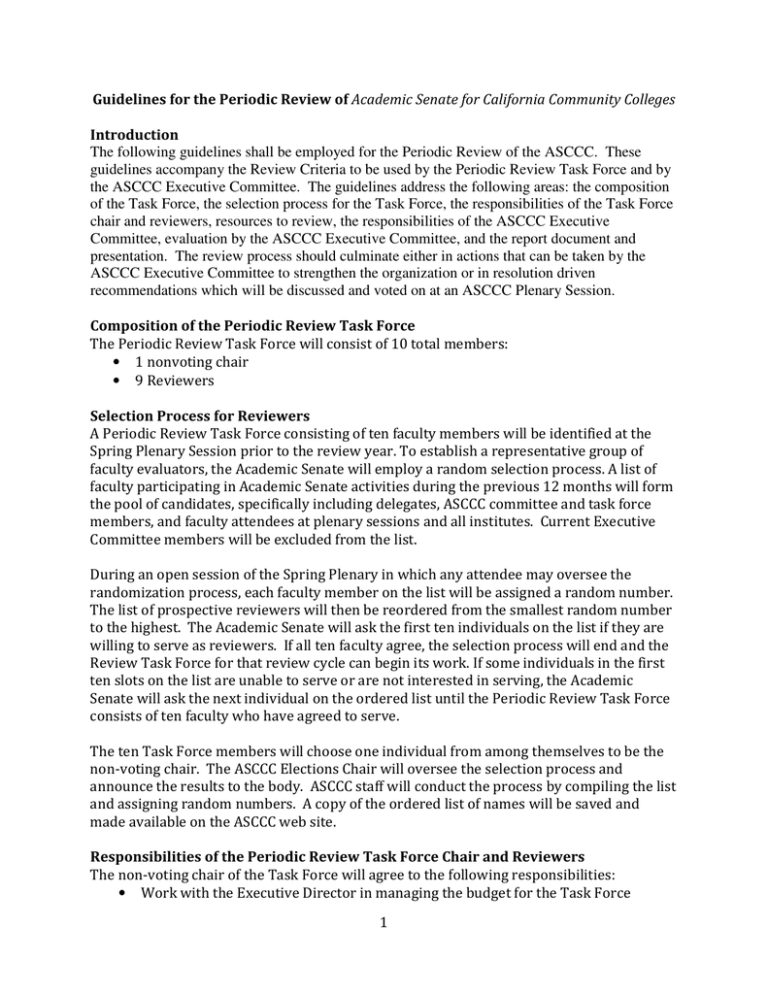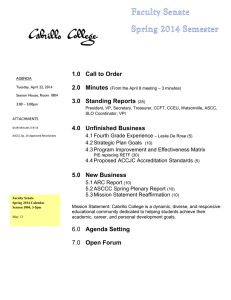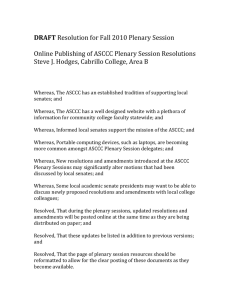The following guidelines shall be employed for the Periodic Review... guidelines accompany the Review Criteria to be used by the... Guidelines for the Periodic Review of
advertisement

Guidelines for the Periodic Review of Academic Senate for California Community Colleges Introduction The following guidelines shall be employed for the Periodic Review of the ASCCC. These guidelines accompany the Review Criteria to be used by the Periodic Review Task Force and by the ASCCC Executive Committee. The guidelines address the following areas: the composition of the Task Force, the selection process for the Task Force, the responsibilities of the Task Force chair and reviewers, resources to review, the responsibilities of the ASCCC Executive Committee, evaluation by the ASCCC Executive Committee, and the report document and presentation. The review process should culminate either in actions that can be taken by the ASCCC Executive Committee to strengthen the organization or in resolution driven recommendations which will be discussed and voted on at an ASCCC Plenary Session. Composition of the Periodic Review Task Force The Periodic Review Task Force will consist of 10 total members: • 1 nonvoting chair • 9 Reviewers Selection Process for Reviewers A Periodic Review Task Force consisting of ten faculty members will be identified at the Spring Plenary Session prior to the review year. To establish a representative group of faculty evaluators, the Academic Senate will employ a random selection process. A list of faculty participating in Academic Senate activities during the previous 12 months will form the pool of candidates, specifically including delegates, ASCCC committee and task force members, and faculty attendees at plenary sessions and all institutes. Current Executive Committee members will be excluded from the list. During an open session of the Spring Plenary in which any attendee may oversee the randomization process, each faculty member on the list will be assigned a random number. The list of prospective reviewers will then be reordered from the smallest random number to the highest. The Academic Senate will ask the first ten individuals on the list if they are willing to serve as reviewers. If all ten faculty agree, the selection process will end and the Review Task Force for that review cycle can begin its work. If some individuals in the first ten slots on the list are unable to serve or are not interested in serving, the Academic Senate will ask the next individual on the ordered list until the Periodic Review Task Force consists of ten faculty who have agreed to serve. The ten Task Force members will choose one individual from among themselves to be the non-voting chair. The ASCCC Elections Chair will oversee the selection process and announce the results to the body. ASCCC staff will conduct the process by compiling the list and assigning random numbers. A copy of the ordered list of names will be saved and made available on the ASCCC web site. Responsibilities of the Periodic Review Task Force Chair and Reviewers The non-voting chair of the Task Force will agree to the following responsibilities: • Work with the Executive Director in managing the budget for the Task Force 1 • • • • • • Develop the meeting schedule in consultation with the reviewers Attend both Fall and Spring Plenary Sessions (ASCCC will finance attendance) Sign a statement of responsibility to be fair, responsible, and professional and to have no conflicts of interest Attend all meetings of the Task Force Coordinate the completion of the Task Force report and submit the report to the Executive Committee no later than the February Executive Committee meeting After consideration of the response and input of the Executive Committee, present a completed report to the body at the Spring Plenary Session The nine voting reviewers of the Task Force will agree to the following responsibilities: • Be available to attend both Fall Plenary to hold a breakout and Spring Plenary to present the report, though attendance at both events may not be required • Determine in consultation with the chair which reviewers will attend and participate in each plenary session presentation, • Coordinate the completion of the report and submit the report to the Executive Committee no later than the February Executive Committee meeting • After consideration of the response and input of the Executive Committee, bring forward a completed report to the body at the Spring Plenary Session • Sign a statement of responsibility to be fair, responsible, and professional and to have no conflicts of interest • Attend all meetings of the task force unless prevented from attending a specific meeting by extenuating or emergency circumstances Resources to Review Periodic Review Task Force members will base their report on the following resources: • http://www.asccc.org/content/executive-committee-information • ASCCC Mission, Values, Bylaws, Policies, and Procedures • ASCCC Program page • ASCCC Resolutions page • Interviews with Executive Committee members, ASCCC committee and task force members, and other individuals as appropriate • ASCCC Annual Report • Executive Committee Internal Evaluation • Surveys • Other resources as determined to be appropriate by the Review Task Force Responsibilities of the ASCCC Executive Committee Executive Committee members are required to participate in the Review Process by providing information when requested, being available for interviews by the reviewers, and striving for honesty, integrity, and professionalism in their interactions with the reviewers. The Executive Committee is responsible for approving the budget for the Periodic Review Task Force’s work and providing any necessary resources in a timely manner to ensure that the reviewers are able to complete their work. Additionally, the Executive Committee shall complete an internal evaluation. Finally, the Executive 2 Committee may compose a response to the findings of the Task Force to address any factual errors or if the Executive Committee determines that a need to provide additional context or interpretation of events or actions. Evaluation by the Executive Committee The members of Executive Committee possess a unique perspective on the decisionmaking, planning, and advocacy efforts of the Academic Senate that is derived from their daily efforts representing the faculty of the California Community Colleges. To assist the Periodic Review Task Force, the members of the Executive Committee will prepare an internal evaluation of the Academic Senate based upon same Areas of Review being considered by the Task Force. The evaluation will consist of individual Executive Committee members’ analysis of how effectively the Academic Senate is working in each of the Areas of Review. It should include specific details that support the statements made and information regarding resources through which the evaluation team can locate additional details. The Executive Committee will complete this internal evaluation prior to the beginning of the Spring Plenary session that initiates the review process. Report Content and Presentation The report of the Periodic Review Task Force will include both commendations and recommendations regarding the work of the ASCCC as a whole and in specific of its Executive Committee. The Task Force will present the report in person at a meeting of the Executive Committee no later than February of the year in which the evaluation is being conducted. The Executive Committee will have this opportunity to request clarifications regarding the recommendations and commendations or evidence of findings or to offer further information to the Task Force. The Task Force will then present its final report to the body of the ASCCC at the Spring Plenary Session. The Executive Committee will consider all recommendations and commendations but will not be bound to any specific action by the report itself. Recommendations from the report may be implemented and become direction to the Executive Committee through the ASCCC resolution process. Such recommendations may be introduced by the Executive Committee itself or by any member of the ASCCC body. Review Cycle The ASCCC Executive Committee will initiate this evaluation process every four academic years. The ASCCC will complete the selection process for the Review Task Force in Spring 2015 and undergo and complete its first Periodic Review of the ASCCC by the Spring 2016 Plenary Session. Evaluation of the Periodic Review of the ASCCC Process The ASCCC will assess the efficacy of the Periodic Review of the ASCCC process, including the Guidelines for the Periodic Review of the Academic Senate for California Community Colleges and Periodic Review of the Academic Senate for California Community Colleges Review Criteria, after completion of the first periodic review and report back to the body any modifications or adjustments by Spring 2017 Plenary Session 3


